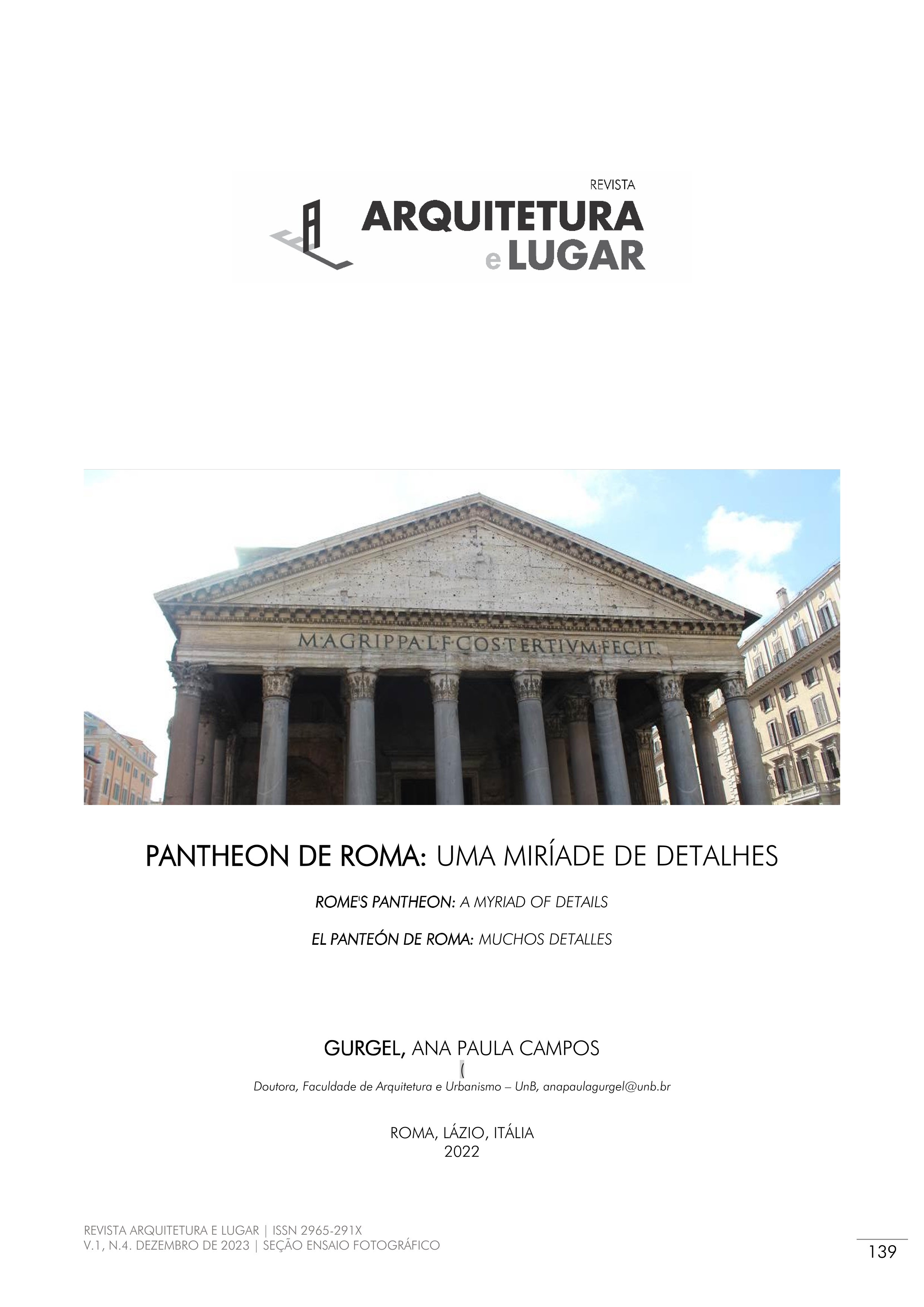PANTHEON DE ROMA
UMA MIRÍADE DE DETALHES
Palabras clave:
Roma, Panteão, Francesco Borromini, intervençãoResumen
El Panteón de Roma es uno de los edificios más emblemáticos de la arquitectura occidental. Construido como un templo dedicado a todas las deidades, fue fundado en el año 27 a.C. por Marco Vipsanio Agripa y posteriormente reconstruido por el emperador Adriano, presumiblemente en el año 124 d.C. Durante la Edad Media el edificio fue reconvertido en iglesia cristiana dedicada a Santa María y los Mártires, función que se mantiene en la actualidad. Se trata, por tanto, del único edificio de la Antigua Roma que se ha mantenido prácticamente intacto y en uso ininterrumpido con fines religiosos desde el momento de su fundación. Sin embargo, aunque poco de su estructura espacial interna ha cambiado, el edificio ha sufrido una serie de cambios a lo largo de los años. Construida en una sección de Roma llamada Campus Martius (Campo de Marte), esta parte de la ciudad era una llanura aluvial propensa a inundaciones regulares por parte del río Tíber, que depositaba capa tras capa de sedimento. A medida que el suelo alrededor del Panteón se elevaba más de 8 metros, el nivel del suelo del Panteón se hundía cada vez más por debajo del nivel del suelo de la ciudad circundante. Además de esta entrada rebajada, se puede comprobar en las representaciones del edificio realizadas por el holandés Maerten Van Heemskerck que datan del siglo XVI que su fachada frontal contaba con un campanario central, sólo siete de las ocho columnas y parte del tímpano. También faltaba debido a la ubicación del edificio: la Sala Capitular estaba adjunta al lado este del Panteón. En el siglo XVII, el Papa Urbano VII Barberini encargó a Francesco Borromini que diseñara un sustituto de madera para las vigas de bronce y una columna adecuada para sustituir la fea pared de ladrillos del pórtico. Una de las justificaciones de esta reforma fue la necesidad de utilizar bronce (el último ejemplo conocido de estructura totalmente metálica construida antes de la era moderna) para realizar el Baldaquino de São Pedro. En el lado izquierdo de la entrada hay una placa de mármol con palabras en latín que justifican la apropiación por parte del Papa Urbano VIII de las antiguas vigas de bronce del techo. Parte de la inscripción se refiere a las celosías de bronce destruidas como "un adorno inútil y casi olvidado". Hoy se sabe que esta placa no es más que una estrategia propagandística del Papa para encubrir el verdadero destino de este bronce: proporcionar más cañones para el Castel Sant'Angelo. Además, el campanario central, añadido en la Edad Media, fue eliminado y sustituido por otros dos colocados sobre el frontón. Esto cambió significativamente su apariencia y provocó reacciones negativas del público: pronto la gente comenzó a llamar a las torres "orejas de burro". Finalmente en 1883, el Papa Pío IX eliminó los campanarios dándonos la imagen exterior que vemos hoy. Este ensayo fotográfico pretende ilustrar estas modificaciones emprendidas en el siglo XVII como registro arquitectónico de la poco conocida obra borrominiana.
Descargas

Descargas
Publicado
Cómo citar
Número
Sección
Licencia
Derechos de autor 2023 Revista Arquitectura y Lugar

Esta obra está bajo una licencia internacional Creative Commons Atribución-NoComercial-SinDerivadas 4.0.
Los autores que publican en esta revista aceptan los siguientes términos:
1. Los autores mantienen los derechos de autor y otorgan a la revista el derecho de primera publicación, estando la obra licenciada simultáneamente bajo la Licencia Creative Commons Atribución-No Comercial-SinDerivadas 4.0, que permite compartir la obra con reconocimiento de autoría y publicación inicial en esta revista;
2. Los autores están autorizados a celebrar contratos adicionales por separado, para la distribución no exclusiva de la versión del trabajo publicado en esta revista (por ejemplo, publicación en un repositorio institucional o como capítulo de libro), con reconocimiento de autoría y publicación inicial en esta revista;
3. Se permite y se anima a los autores a publicar y distribuir su trabajo en línea (por ejemplo, en repositorios institucionales o en su página personal) una vez finalizado el proceso editorial, ya que esto puede generar cambios productivos, así como aumentar el impacto y la citación del trabajo. trabajo publicado (ver El efecto del acceso abierto);
4. No se recomienda publicar y distribuir el artículo antes de su publicación, ya que esto puede interferir con su revisión ciega por pares.



